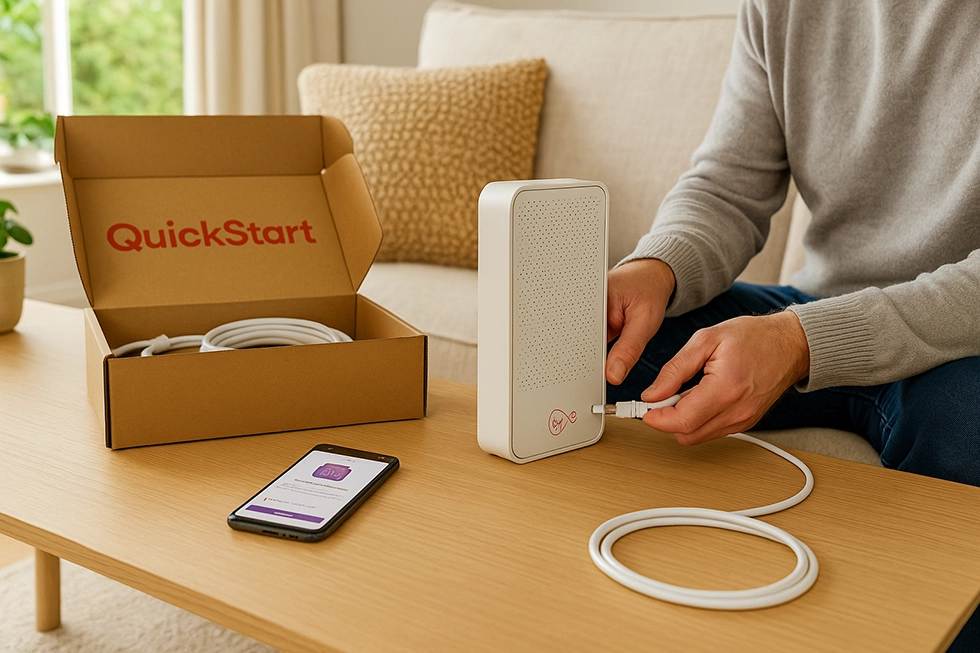Hyperoptic Total Wi-Fi & Minihub Review
If you’re already with Hyperoptic or considering their full-fibre broadband, their Total Wi-Fi mesh service acts like the finishing touch to the package. It extends your Wi-Fi signal into rooms, floors or tricky corners where the router on its own might struggle.
At the heart of it is the Minihub—a compact extender that works with your Hyperhub router to give you better coverage and fewer dead spots. Since Hyperoptic’s network is full-fibre (FTTP), you already have a strong foundation; Total Wi-Fi amplifies that wireless reach around your home.

Main Features
- Total Wi-Fi allows you to add a mesh-Wi-Fi setup to your existing Hyperoptic broadband whenever you like—at order time or later.
- The package includes a Minihub, described as “small but mighty” and designed to blend into your home décor.
- Should one Minihub not cover your home fully, you can request a second to extend the mesh further.
- Hyperoptic explains that mesh Wi-Fi helps eliminate dead spots and delivers stronger wireless throughout your property—from basement to bedroom.
- You can manage setup via your account support page or using the mobile app of the Minihub model you have.
Technical Specs
| Component | Details |
|---|---|
| Add-on | Total Wi-Fi |
| Extender | Minihub (one included, optional extra) |
| Compatibility | Works with existing Hyperhub router models supplied by Hyperoptic (Zyxel, Nokia, ZTE etc) |
| Connection options | Wireless setup via app or wired connection via Ethernet recommended |
| Coverage aim | Full-home coverage, fewer dead zones, automatic device hand-off between nodes |
| Cost | £7/month |
How Total Wi-Fi Works
Mesh Wi-Fi uses a main router plus one or more nodes (satellite devices) that communicate with each other to blanket your space with wireless signal. In this case, your Hyperhub acts as the base and the Minihub acts as the node.
Devices switching rooms will automatically connect to the node with the stronger signal rather than hanging on to a weak one. That means fewer drops or buffering when you move between floors or rooms.
You can link the Minihub to the router via Ethernet (which offers best performance) or wirelessly (more flexible). Hyperoptic’s guides suggest you use a wired connection if possible for the strongest result.
Hardware Overview: The Minihub
The Minihub comes in different hardware flavours depending on which router you have—Zyxel, ZTE or Nokia—Hyperoptic confirms this in their router & extenders page.
It features a compact, stylish design so it doesn’t look out of place. Hyperoptic say “with a beautifully sleek design, intended to subtly blend in.”
Inside the box you’ll typically find: the Minihub unit, power adapter, Ethernet cable (for wired backhaul if you choose), and quick-start guide.
LED indicators on the Minihub show you connection status; if the link LED flashes green it might mean it’s too far from the router and you may need to relocate.
Setup & Placement
Setup – Two simple paths
- Wired backhaul (best performance) – connect Minihub’s WAN port via Ethernet to a LAN port on your Hyperhub router; power it on and wait for the Link and Power LEDs to go green.
- Wireless connection (more flexible placement) – use the app (e.g., ZLife Lite, MPro Mesh) to configure the Minihub wirelessly; once synced, place it in the optimal spot.
Placement tips
For best results:
- Place the Minihub in a central location relative to the area you want to cover, not hidden away behind obstacles.
- Avoid positioning it too far from your router; a flashing green link light may signal weak connection.
- Thick walls and multiple floors reduce wireless signal; using Ethernet backhaul or adding another Minihub can help.
- If you live in a large home or one with many floors, ask Hyperoptic for a second Minihub.
Compatibility & Requirements
Total Wi-Fi will only work with Hyperoptic’s supported routers and Minihubs—third-party mesh kits will not integrate with Hyperoptic’s firmware or support system. Some customers on forums report that non-Hyperoptic mesh gear won’t pair correctly.
Your Hyperhub must already be connected and fully functioning before fitting the Minihub. Hyperoptic emphasises you must have the router working first.
Other than that, just power and possibly an Ethernet cable, and you’re good. Remember: Wired backhaul yields best stability; the wireless link will work but may suffer interference.
Performance Expectations
With Total Wi-Fi in place, you should see improved wireless coverage, fewer dead spots and more reliable performance across your home—especially in rooms far from the router. Hyperoptic’s marketing states “ultimate speed, reliability and coverage – in every room.”
While the service doesn’t alter your core broadband speed (that remains whatever your main package offers), better Wi-Fi means your devices will access much more of that available bandwidth rather than being slowed by weak wireless signal.
Work from home, video calls, streaming and online gaming all benefit when the Wi-Fi signal is strong and consistent. If you rely heavily on Wi-Fi rather than wired connections, Total Wi-Fi can make a noticeable difference.
On forums, some customers report that wired backhaul from Minihub to router gives best results, and wireless only setups can vary depending on walls, floors and distance.
Pricing, Contract & How to Add It
You can add Total Wi-Fi when you first sign up for Hyperoptic broadband, or later via your account if you already have a service.
The standard add-on cost is £7 per month (subject to promotions).
Important contract detail: If you add the mesh service part-way through an existing contract (12- or 24-month), Hyperoptic may require you to move to a new package (with potentially different price) and restart the minimum term commitment.
For this reason, it’s worth checking the terms before you commit.
Customer Support & Troubleshooting
Hyperoptic offers help through their “Help Centre” and via “My Account Support”. They maintain setup guides and video tutorials for Minihub installation.
Common issues and solutions in the troubleshooting guide include moving the Minihub closer to the router if the link LED flashes green, using Ethernet cable for backhaul if wireless performance lags, and resetting to factory settings if needed.
In user forums, one recurring feedback is: “The main benefit is if something goes wrong, it’s Hyperoptic’s problem if you’re on Total Wi-Fi.” But a caution: Some users say the mesh setup’s firmware and app features are more basic compared to high-end independent mesh kits.
Pros and Cons
Pros
- Adds extend-your-home wireless reach to existing full-fibre broadband.
- A single network name across router and Minihub(s) means seamless device switching.
- Simple to add via account; scalable (add second Minihub if needed).
- Works well for multi-floor or large homes where a single router struggles.
Cons
- Performance still depends on property layout—large walls/floors may limit wireless link.
- £7/month extra cost adds up over contract term.
- If you add mid-contract you might restart your minimum term.
- Mesh firmware and app features may lack advanced controls available in third-party systems.
- Only works with Hyperoptic approved routers and Minihubs; you can’t simply plug your own mesh kit in.
Verdict
If your broadband connection is already top-tier (full-fibre from Hyperoptic) but your Wi-Fi doesn’t cover your home reliably, then Total Wi-Fi is a worthwhile enhancement. It doesn’t raise your broadband speed per se, but it helps you access what you’ve got more consistently—especially in rooms or floors the main router struggles to reach. For many homes, once you install the Minihub and configure properly, the wireless experience improves significantly.
However, if you live in a small property where the router alone reaches all rooms, or you already own a high-end independent mesh system, you might find the extra monthly cost and possible contract re-start less attractive. In short: for homes needing better wireless reach, it’s a smart add-on; for homes already well covered, you may not notice as much difference.
Who Should Choose Total Wi-Fi?
You’d be well suited to Total Wi-Fi if:
- You live in a large house, multi-storey property or with many internal walls.
- You work from home and rely on Wi-Fi for video calls/large uploads rather than wired Ethernet.
- You stream in several rooms, use multiple devices simultaneously and need seamless roaming.
- You are already a Hyperoptic broadband customer and want an integrated mesh solution, backed by support.
Who Should Consider Alternatives?
You might want to look elsewhere if:
- Your current router already covers your home and you don’t experience Wi-Fi drop-outs.
- You have a smaller flat or simple layout where a single router is enough.
- You prefer owning and controlling a third-party mesh kit from TP-Link, Netgear, Asus or Ubiquiti which may offer more advanced features.
- You are concerned about restarting contract terms or paying extra monthly for the add-on.
FAQs
Does Total Wi-Fi replace my Hyperhub router?
No. Total Wi-Fi adds the Minihub as an extender. You still use the Hyperhub router as your primary connection device.
How many Minihubs do I get and can I add more?
One Minihub is included by default. If required, you can request an additional one to extend coverage further.
Can I use my own mesh Wi-Fi kit instead?
Technically you could, but Hyperoptic’s Total Wi-Fi is designed to integrate with their system and they only support approved Minihubs. Some users report compatibility issues with third-party extenders.
Will adding Total Wi-Fi change my contract length or price?
Yes, if you add it mid-way through a 12- or 24-month contract, Hyperoptic may require you to move to a new package and restart your minimum term. Check the terms carefully.
Where should I place the Minihub for best performance?
Place it in a central, unobstructed part of the home where you currently get poor Wi-Fi coverage. Avoid hiding it behind furniture or too far from the router. If the link LED flashes green, try moving it closer to the router.
Final Thoughts
Total Wi-Fi from Hyperoptic is a practical and effective way to boost your wireless coverage and make the most of your full-fibre connection.
If you see weak Wi-Fi in certain rooms or want better roaming across devices, the Minihub mesh system offers a well-integrated, supported solution.
Just weigh the extra cost and contract implications before you commit—and make sure your setup is optimised (wired backhaul if possible) to get the best results.




